Snake plant care and growing tips: expert houseplant advice
Our expert guide has lots of practical tips on snake plant care so you can ensure this much-loved houseplant will thrive in your home
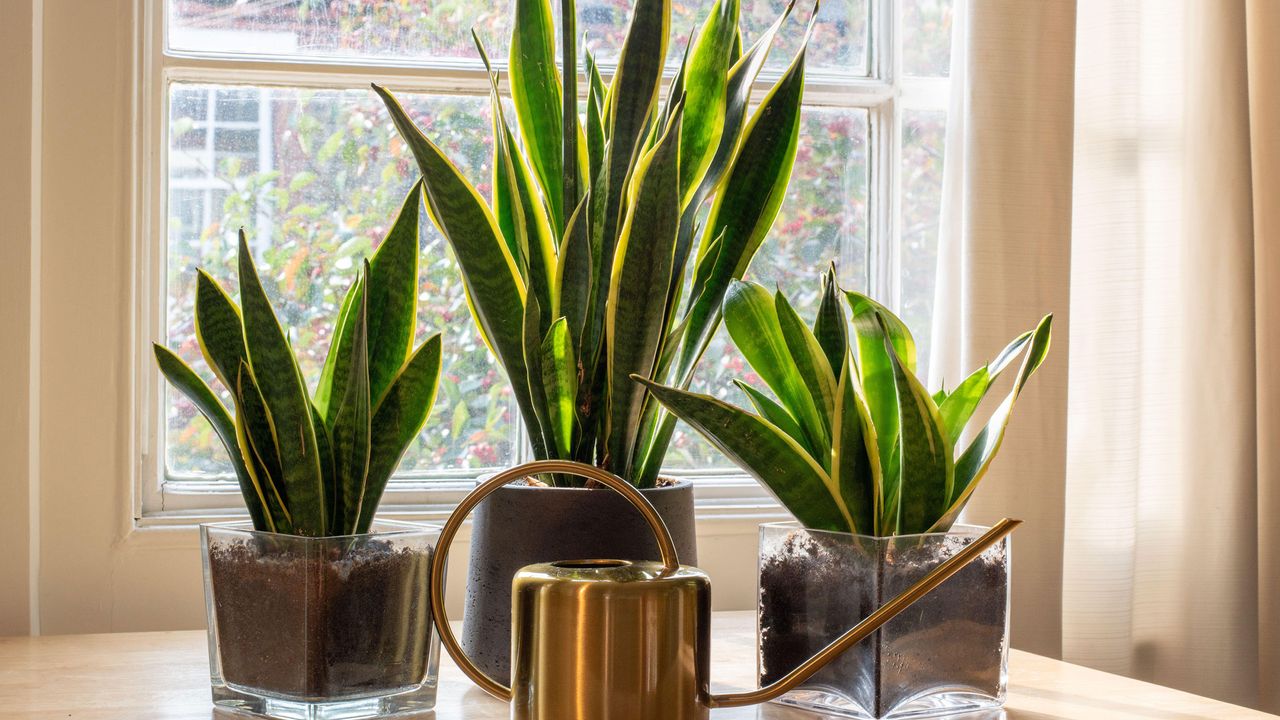

With our tips on snake plant care, you'll soon realise it's one of the easiest houseplants you can grow.
Also known as ‘Mother in Law’s Tongue’ and sansevieria, 1970s favourite the snake plant is having a revival. It's a good choice if you want something with a compact growing habit yet need some height. Better still, they improve the air quality of your home and are virtually impossible to kill.
It’s a good houseplant for shelfie moments on Insta too, with its spectacular blade-like leaves with bands of lighter green or distinctive yellow (the variegated Sansevieria trifasciata ‘Laurentii’) markings along the edges.
Snake plants are definitely one of the best indoor plants thanks to their unfussy needs. But even though they’re super easy to grow, make sure you max up your plant’s potential by following our expert snake plant care tips.
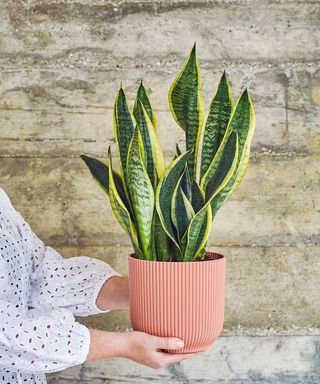
Snake plant in Elho vibes pot from Beards & Daisies
Top tips for snake plant care
If you're looking for an easy houseplant option you're in the right place. ‘It’s hard not to love the snake plant as it ticks every box,’ says Jo Lambell, founder and plant expert at Beards & Daisies. ‘Don't let the name fool you though, as there's nothing sly about these plants. They're actually one of the best plants for beginners as they're so incredibly easy to care for.’
From where to position one to how often to water plus more, we’ve rounded up all the expert tips you need on how to care for snake plants so you can get the most from your beautiful specimen. Here are the key things you need to know to ensure this houseplant favorite takes center stage in your indoor garden ideas.
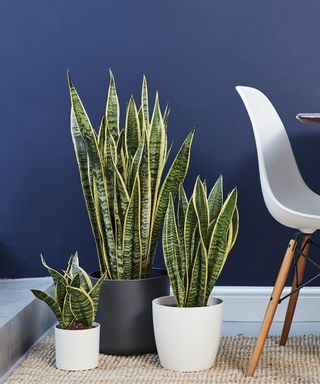
Snake plants from a selection at Patch Plants
1. Don’t overwater it
It’s such an easy plant to grow that the only real danger is overwatering your snake plant. Always keep the compost on the dry side, especially during the winter months. Water sparingly in winter, just enough to prevent the soil drying out completely.
‘You could go weeks without watering your snake plant and it would still be healthy and thriving. We told you it was one of the best low maintenance indoor plants!’ says Jo Lambell. ‘As a rough guide, allow the soil to dry out each time before watering plants. And pour the water directly into the soil rather than over the leaves.’
In summer, water your snake plant moderately, leaving the top half of the soil to dry out in between watering times. Always make sure you let the water drain away. If you let the plant sit in water it may cause the roots to rot.
For another hassle-free houseplant option, you can't go wrong with a Swiss cheese plant.
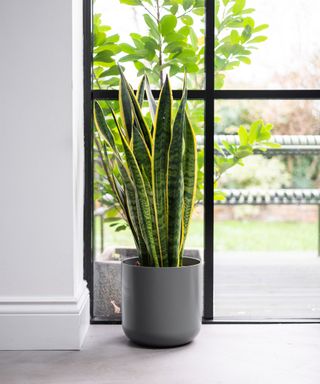
Snake plant Laurentii from The Stem
2. Choose the right spot
When it comes to snake plant care, your plant will do best in full sun but will thrive in shaded situations too – it’s really not that fussy. It doesn’t mind darker spots like hallways and if you like plants on the stairs it works well because of its upright habit and the fact it doesn’t mind drafts either.
‘The snake plant isn’t too fussy or particular about where it is homed,’ says Jo Lambell. ‘Access to bright, indirect light is best, but it can tolerate shadier spots, too. It's one of the best plants for bedrooms as it’s a fantastic air purifier, removing toxins such as formaldehyde and benzene from the home. It will also store oxygen throughout the day and then release it back into the atmosphere at night, ensuring you're breathing good quality air and aiding a restful night’s sleep.’
Just one thing to bear in mind. 'If you have a baby, young children, or pets, you should be aware that snake plants can be mildly toxic if ingested,' says Patch Plant’s Plant Doctor Richard Cheshire.

3. Use soil-based compost
Choose a soil-based compost for larger snake plants where the weight of the soil is needed to balance the quite heavy, tall leaves. Add some horticultural grit if your snake plant is tall, as well as planting it in a heavy pot to prevent it toppling over.
Smaller plants and the dwarf variety Sansevieria trifasciata ‘Hahnii’ will do well planted in an all-purpose cactus potting soil.
As snake plants are slow growing it’s usual for the roots to really fill out the pot so there’s no hurry to repot it. Strong roots can easily crack plastic pots when your plant outgrows its space though and that's the time to find out how to repot a plant to make sure you do it properly. The best time to repot a snake plant is in spring.
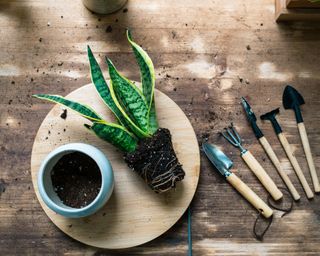
Displaying snake plants in your home
The snake plant is the star of the indestructible houseplant list. As long as you put it near a natural light source and water it occasionally it will be hard to kill. It can also deal with temperature changes as well as being okay with drafts. This makes it tolerant of all degrees of light, shade and heat – our kind of plant.
When it comes to indoor plant ideas be sure to include several snake plants in your houseplant collection. 'Different kinds of snake plant look great placed together, the different variations in the leaves make stunning focal points for a room,' says Stem founder James Folger. 'They are great for busy people who haven’t got tons of time. They come in a variety of sizes and are architectural masterpieces. They really make a statement without a huge investment financially.'
Air purifying plants are always on trend as we become more and more aware of our immediate environment. 'The snake plant is known to be an expert at filtering out the bad stuff,' says James. 'Place them side-by-side in varying heights in a hallway for a dramatic "wow" moment for your entrance.'
Grow a big pot of tall leaves to show off in a modern setting. 'As they are quite variegated/patterned, we like to style them in a plain and simple pot, white looks especially impactful,' says Jamie. You might even be lucky and get a tall spike of fluffy green-white flowers that springs up from the base of the plant.
If you want to try something smaller the dwarf and compact form Sansevieria trifasciata ‘Hahnii’ has circular leaves in a rosette and looks more like a succulent.

How do I look after snake plant leaves?
These beautiful sword like leaves are easy to care for. Wipe the leaves occasionally, to prevent dust building up. Be careful not to damage the leaf tips as this can harm your plant’s growth. Put the mister away on this occasion as these are one variety of houseplant that doesn’t need misting.
‘The snake plant has a waxy texture to its leaves and for that reason, it can be prone to attracting dirt and dust to its long foliage,’ says Jo Lambell. ‘Keep them clean by gently wiping the leaves down with a damp cloth. This will help the plant to breathe better, too, as its pores are not blocked, meaning it can access more light.’
If you love houseplants with stunning leaves, take a look at prayer plant care for another variety to love.
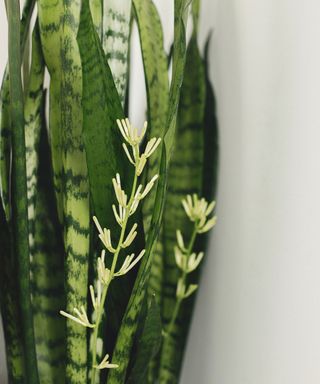
How do I propagate a snake plant?
As with other indoor plants such as aloe vera, you can add to your snake plant family for free by propagating your existing plant.
It's super easy to take cuttings from plants as new plants are obtained by simply dividing off well rooted side shoots. Cut away a leaf and a piece of root, and plant it up in a small pot of fresh compost. Water well and put the cutting in a bright spot, out of direct sunlight.
Plants can also be raised from taking leaf cuttings but these will all be green leaved, even if the leaf sections have the golden variegation patterning.
The snake plant has thick fleshy roots that are so powerful they can bend a plastic pot and can even lift the plant out of the soil. If this happens cut the side shoot with a sharp knife and replace the plant firmly in its pot.
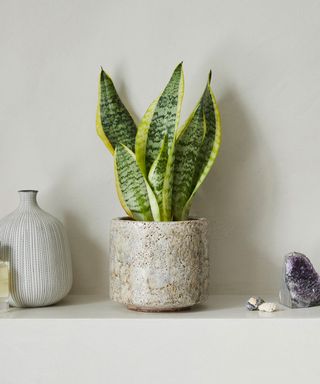
Snake plant from a selection at Patch Plants
How do I increase my snake plant growth?
The snake plant is very slow growing, producing only one or two new leaves each year. It will eventually form a tall plant up to 3ft (around 1m) tall but you'll need to be patient. Alternatively buy a nice tall plant in the first place.
If you want your snake plant to keep producing new leaves, keep it to a temperature of 60˚F (15˚C) but they will thrive in lower winter temperatures and can even survive short spells as low as 45˚F (7˚C).
Exposing your snake plant to more sunlight will also give it a boost. Fertilizing plants is another great idea. Giving your snake plant a helping hand with a liquid feed once a month, from mid spring to early autumn, is beneficial for growth. Try a cactus fertilizer during the growing season or a balanced liquid slow-release fertilizer diluted to half-strength. When it comes to how to care for houseplants in winter, however, our advice is to knock back on the fertilizer during the colder months.
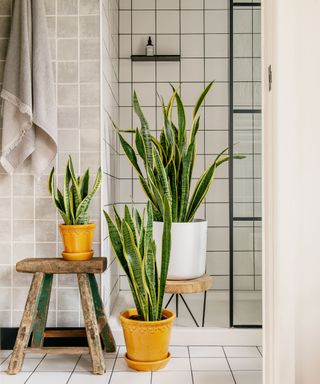
Snake plants from Beards & Daisies
How do you take care of an indoor snake plant?
There is not a lot of maintenance required for snake plant care, but it's worth keeping the following in mind.
- Removing leaves will give your plant a boost and promote new leaf growth, as well as keep it looking smart.
- Use a sharp knife to remove any damaged, blotched or old leaves, taking them right back to the base to encourage new growth.
- The best time to prune is during the growing season in spring or summer. Don’t do it during the dormant phase as this will stress your snake plant.
- Yellow leaves are a sign of overwatering, especially in winter. Remove any rotting foliage and let the compost dry out completely.
- Wrinkled leaves mean you may have under-watered your plant. Lightly water it and monitor, topping up as necessary and it should revive.
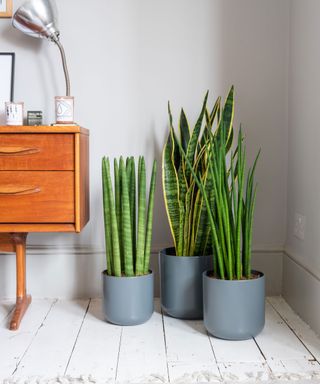
Snake plants from The Stem
Where to buy snake plants
Now you know about snake plant care (so simple!), you probably want one of your own. They’re often available in garden centers and even grocery stores, but you can also shop for them online for extra convenience.
Our quicklinks will help you start your search.
Where to buy snake plants in the US:
Where to buy snake plants in the UK:

Lifestyle journalist Sarah Wilson has been writing about gardens since 2015. She's written for Gardeningetc.com, Livingetc, Homes & Gardens, Easy Gardens and Modern Gardens magazines. Having studied introductory garden and landscape design, she is currently putting the skills learned to good use in her own space where the dream is establishing a cutting garden.
